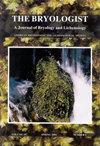Pyrenula ochraceoflava群(Pyrenulaceae)的系统发育显示了近隐式的多样化和包含Mazaediothecium相册聚集体
IF 1.5
4区 生物学
Q4 PLANT SCIENCES
引用次数: 0
摘要
摘要在这项研究中,我们对赭色核果属(核果科)进行了分析,重点是新热带地区,并基于mtSSU、nuLSU和ITS标记的形态、化学和分子数据。我们描述了来自墨西哥热带干燥森林的三个新物种,证实了赭叶粉蝶群的单系性,并为目前位于Pyrenula内的Mazeodothecium属物种的包含提供了证据。金黄色核霉菌(Pyrenula aurantiacoretis sp.nov.)的特征是一种橙色色素以网状方式覆盖铊,具有4排1-4个细胞的鼠形子囊孢子,12–15.5×8–10.5µm,7-氯大黄素和大黄素是主要化合物。Pyrenula connexa sp.nov.与Mazediothecium album亲缘关系密切,其特征是类马祖核果、基部和侧部切除基部碳化、高度可变的成熟子囊孢子、1-隔至亚脲状、具有大量白色疣的铊和作为主要化合物的地衣。霉菌Pyrenula moldenkourum sp.nov.的特征是一个橙色的铊,亚脲形子囊孢子,经常显示着色的隔膜形成交叉隔膜模式,大小为7.5-11×5.5-8.5µm,7-氯大黄素和大黄素是主要化合物。简要讨论了该类群中最常见和分布最广的物种——赭色粉蝶和赭色粉蝶的分类学,为支持将赭色花粉蝶视为一个物种复合体提供了证据。两个物种Mazaedothecium album和M.mohamedi被转移到Pyrenula作为P.aptrootiana nom。nov.[非Pyrenula alba(Schrad.)A.Massal.]和P.mohamedi comb。十一月本文章由计算机程序翻译,如有差异,请以英文原文为准。
Phylogeny of the Pyrenula ochraceoflava group (Pyrenulaceae) reveals near-cryptic diversification and the inclusion of the Mazaediothecium album aggregate
Abstract. In this study we present an analysis of the Pyrenula ochraceoflava group (Pyrenulaceae), focusing on the Neotropics and based on morphological, chemical, and molecular data of the mtSSU, nuLSU and ITS markers. We described three new species from tropical dry forests of Mexico, confirm the monophyly of the P. ochraceoflava group and provide evidence for the inclusion of species currently placed in the genus Mazaediothecium within Pyrenula. Pyrenula aurantiacoretis sp. nov. is characterized by an orange pigment covering the thallus in net-like fashion, muriform ascospores with 4 rows of 1–4 cells each, 12–15.5 × 8–10.5 µm, and 7-chloroemodin and emodin as major compounds. Pyrenula connexa sp. nov. is closely related to Mazaediothecium album, being characterized by mazaedioid pyrenocarps, basal and lateral excipular carbonization, highly variable mature ascospores, 1-septate to submuriform, thallus with abundant white verrucae, and lichexanthone as major compound. Pyrenula moldenkeorum sp. nov. is characterized by an orange thallus, submuriform ascospores that frequently show pigmented septa forming a cross septation pattern, 7.5–11 × 5.5–8.5 µm in size, and 7-chloroemodin and emodin as major compounds. The taxonomy of the most common and widespread species of the group, P. ochraceoflava and P. ochraceoflavens, is briefly discussed, presenting evidence to support the consideration of P. ochraceoflava as a species complex. The two species Mazaedothecium album and M. mohamedii are transferred to Pyrenula as P. aptrootiana nom. nov. [non Pyrenula alba (Schrad.) A.Massal.] and P. mohamedii comb. nov.
求助全文
通过发布文献求助,成功后即可免费获取论文全文。
去求助
来源期刊

Bryologist
生物-植物科学
CiteScore
2.40
自引率
11.10%
发文量
40
审稿时长
>12 weeks
期刊介绍:
The Bryologist is an international journal devoted to all aspects of bryology and lichenology, and we welcome reviews, research papers and short communications from all members of American Bryological and Lichenological Society (ABLS). We also publish lists of current literature, book reviews and news items about members and event. All back issues of the journal are maintained electronically. The first issue of The Bryologist was published in 1898, with the formation of the Society.
Author instructions are available from the journal website and the manuscript submission site, each of which is listed at the ABLS.org website.
All submissions to the journal are subject to at least two peer reviews, and both the reviews and the identities of reviewers are treated confidentially. Reviewers are asked to acknowledge possible conflicts of interest and to provide strictly objective assessments of the suitability and scholarly merit of the submissions under review.
 求助内容:
求助内容: 应助结果提醒方式:
应助结果提醒方式:


